

The miniature pinscher is also sometimes called the mini pin, and is a small dog breed that originated in Germany. The breed is thought to have a history going back for many centuries, but recorded information on the breed only goes back for a couple of hundred years. Ancestors of the breed are thought to include the dachshund, German pinscher and Italian greyhound.
The mini pin can stand up to 12.5” tall at the withers, and weigh up to 10lb, making them small, fine and lightweight little dogs. Males of the breed tend to be slightly larger than females, but with no significant degree of variance. The breed’s build is compact and sturdy, and well proportioned, with fine, neat lines and no exaggerations. They have a high stepping trotting gait, straight legs and a very neat movement.
The coat of the miniature pinscher is smooth and very short, with no undercoat. While they are most commonly seen in black and tan colour, they can also be seen in a wide range of variants, including stag red, blue stag red, chocolate stag red, and fawn stag red, although not all breed organisations recognise the full range of possible colours within their breed standards.
If you are considering buying or adopting a miniature pinscher, it is important to find out as much about the breed as possible, including learning more about the hereditary health of the breed, and if any health testing schemes are in place for the breed. We will look at these elements in more detail within this article.
The average lifespan of the miniature pinscher is up to fifteen years, which is considered to be a very long lifespan for a pedigree dog. It is certainly not unheard of for dogs of the breed to live well beyond this figure either, and so it is fair to say that the mini pin is a generally healthy breed with a good conformation and general health profile.
The coefficient of inbreeding statistic for the miniature pinscher is 11%, which indicates that the breed as a whole is subjected to a reasonable degree of inbreeding. The ideal figure for pedigree dog breeds is 6.25% or lower, and mini pin breeders are advised to reduce the coefficient of inbreeding statistic within their own breed lines where possible.
The general build and structure of the mini pin is considered to be robust, healthy and well balanced, and not prone to exaggerations. However, blue and fawn dogs of the breed have a tendency to potentially suffer from a condition called colour dilution alopecia, which leads to partial hair loss of the coat.
The British Veterinary Association, The Kennel Club and miniature pinscher breed organisations recommend that potential breeding stock be tested for certain conditions that are prevalent across the breed, and that are hereditary from the parent dogs to their litters.
Current schemes include:
While the miniature pinscher is widely considered to be a robust, fit dog that is not prone to a wide range of ailments, potential buyers and breeders of miniature pinschers should make themselves aware of all of the potential health conditions that are considered to present within the breed as a whole.
Health testing is only widely offered for the conditions mentioned above, but collated data suggests that the following conditions may also affect dogs of the breed:
Finding out about the general health and wellness of the parent and grandparent dogs of any litter you might be considering buying from can help to give you an informed insight into the health of the breed line as a whole, and enable you to make a decision on whether or not to make a purchase.
Copyright © 2005-2016 Pet Information All Rights Reserved
Contact us: www162date@outlook.com